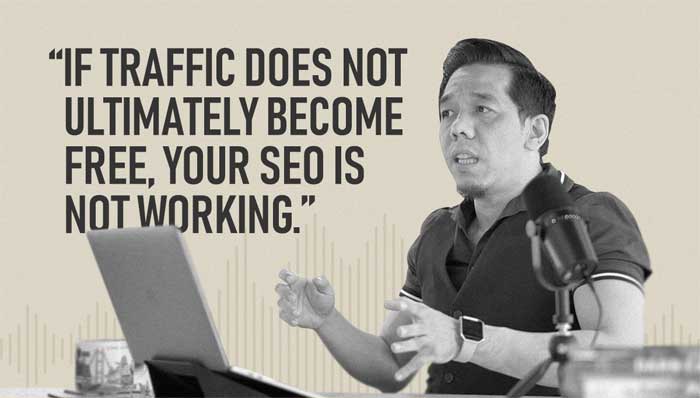Truelogic Episode 80 Recap: Anatomy of an Effective Social Media Ad

Savvy businesses know that it’s essential to have a presence on social media but to have and maintain a strong presence on sites such as Facebook, Twitter, and Instagram is all about the right approach. Having a strong social media content strategy is important for figuring out what you want to say, but what’s just as important is how you say it to make the biggest impression on users. To know more about the elements of effective social media ads, listen in.
Podcast Transcription:
Ant Sierra: You are listening to another episode of the Truelogic DX Podcast. By the way, you’re hearing the voice of Truelogic’s resident wrestling weeb, geek, whatever, and from the social media team. And I am joined by my compatriarchs, Jake and Eka. So we are here to discuss with you guys the elements of what makes effective social media content.
What is a Social Media Ad?
Ant Sierra: Social media ads are the fourth biggest source of brand discovery and the second most popular channel for online brand research. To dive into the numbers, it’s 4.74 billion people across the world use social media. And in 2023 alone, ad spending on social media is projected to reach more than 260 plus or 268 billion.
How Do Social Media Ads Work?
Jake Macapagal: So before we dive into how and what social media ads sound like, who you target, them. First off, you have to choose which platform or platforms you want to place your ads on. So for example, if your brand is for conyo or the rich people, alangan naman you’re going to target a platform that’s known for its ‘masa’ culture. Like for example, your Rolls-Royce, wow, a freaking luxury car. You’re not going to target TikTok because people who are mostly on TikTok, at least here in the Philippines, are kids teens, or young professionals who don’t have that kind of luxury.
Ant Sierra: Eka, how about the platforms, social media ads, or content when it comes to specific campaign goals and objectives?
Erika Agustin: If you like, for example, there are certain brands that we handle. So for example, appliances. So a lot of people look for appliances on Google, right? But before that, we can check on Facebook sometimes and Instagram. And also, when you check them on social media, like checking reviews, it’s usually on Facebook. So you have to know as a brand what’s your goal. So you need this type of audience, these are the things that we want them to see, then you’re going to budget the ad for how many days. And you need to be specific for example, page likes. Do you want them to go to your website, page leads, and then engagement? It’s very important for engagement, especially if you are a new brand ka or you recently made a new page.
Ant Sierra: And I think whatever platform you release content on, they have different ways of entertaining per goal. For example, a lead gen ad works differently on Facebook as compared to when you’re doing lead generation on TikTok. This is where the strategic planning part of handling a campaign on the platform comes in. When it comes to, let’s say, a specific target audience or a specific demographic, for example, your brand wants to target a very niche, let’s say k-pop trading card collectors, would you recommend specifying the platform where they will release their ad or their content or would you rather choose a platform with just many audiences?
Erika Agustin: As a K-pop fan myself, I usually buy on Twitter because it’s mostly legit and you can easily communicate there. You can see when you’re gonna look for a certain product that you like. For me, usually the photo cards. It’s very hard kasi right now to look for legit photo cards. Well, on Twitter, you can easily see the account if they’re a fan of this type of group. So as a social media specialist and of course as a fan myself, I can add that there’s a really big market for K-pop fans on Twitter.
Ant Sierra: There’s a sense of legitimacy when it comes to specific niche audiences, ‘yung particular platforms. Ad creatives. It’s another key component when it comes to social media content works. Creatives, for the most part, because let’s face it, no one’s going to interact with just a text post. You have to accompany whatever it is that you’re trying to imply with something visually appealing. It can be as simple as a headline with an image or as complex as an interactive video. In this case, it is a mixture of both. You can incorporate both when it comes to your content strategy. We’ll be running down more on this in the later part of this episode. But to put it simply, guys, invest in doing a good creative. For the most part, this is where your brand presence is anchored on whatever platform you are on social media. Now, last but not least on how these ads work, campaign management, and success metrics.
Jake Macapagal: Campaign management. You are not going to go full organic because it will not be your only plan for your social media campaign. Let’s narrow it down to Facebook at least.
It goes back to your goal. So what are the things that you wanted to do for this month or this quarter? If you want engagement, you need to tweak your campaign. So this is the time you will make your content plan, strategy, the time, or at least the budget that you’re going to use. So for example, you’re running three engagement ads. Then you observe that ad number two is not performing well, then you have an opportunity to turn off the ad and then reallocate your budgets to one and three, respectively. And then metrics, it come after, I guess. So after you run the ads, you will cross reference your idea and goal for your ads versus the actual results that you get. So for the first month of running your ads, the result will be your metrics for the following month. That will be your standard and then it will get better or get worse depending on the next campaign. So in a way, it’s you measuring yourself a day before. You just compare what you got last month to what you’re getting now. So in a way, that’s how you measure how successful your campaign and your overall management skills are on social media. At least that’s how I’d put it.
Erika Agustin: What Jake said is correct and that’s what also I think about the success metrics of the social media campaigns. It’s really important to know the people that you targeted are the ones who saw your social media posts or social media pages. And of course, your objective must be evident in the metrics.
Benefits of a Social Media Ad
Ant Sierra: Now that we know how social media ads and content work, let’s talk about before we head on to the anatomy, let’s talk about what are the benefits of it. Now, first and foremost, when it comes to targeting specific audiences, you want to be refined as you want. So you can go as broad as to invite everyone to tune into your page, especially when you’re at the top funnel of your marketing strategy. Next is, there’s a variety of ad formats. So it can be an image, carousel, video, reel right now, a product, or a story. You have a lot of options that you can tailor to maximize your brand’s visibility on the platform. You get more from organic social media content.
The real competition is how valuable your ad or content is to the audience on that particular platform. One of the biggest benefits then is reaching new audiences and markets. For example, you have a bullseye audience in your head as a brand manager or as a business owner, you thought that’s the only potential audience that your brand can cater to. While in fact, there are people you haven’t explored yet. That is one of the biggest gifts that having a social media ad or content to give you. Last but not least, it builds long-term relationships with your customers.
Jake Macapagal: As shallow as it sounds, the more entertaining your content is, the more people are going to like it. Not like thumbs-up likes, but like in general they like what they are seeing. So you need to captivate your audience in the shortest amount of time possible. People would much rather get the gist of what you’re saying from the get-go instead of going through a few more seconds for the build-up. You’re fighting for their attention span. So you have to get in there, knock them out with your messaging, and hope that they stay.
Erika Agustin: That is important to be relatable with your audience, too, for people to go or for the brand to go viral, it’s very important that the audience, the target audience or even your possible audience, prospect audience can relate to what you are posting to your brand’s image and your brand’s communication style.
Ant Sierra: So you have to give them a reason. And that’s through relatability. I encourage, especially if you’re on the creative side of things, to always think of messaging and stories in your head that inspire, encourage, and affirm. This brings us to the last key element which is evoking an emotional response. Because the emotional response is a very much social testament that you are connecting with your audience in one way or another.
Let’s say you are a mom or a single parent of a brand, your target audience is moms. Pero, you are a baby brand. I won’t mention names, but let’s say you are a baby brand. When you are crafting an ad or content you want to hit all of these key elements to get a positive response. You have to, you’re going to formulate pain points in your head what if this scenario happens to this audience would connect with? For example, if you’re targeting moms, one of the key emotions is their baby’s first words, baby’s first bath.
Erika Agustin: So if you provide entertainment value, of course, there’s an emotional response. The people who see the ad or the post, feel happy, they feel excited, or enjoy the content. And of course, if they enjoy the content, it means they relate to the content, too. So to make the long story short, it’s a bundle of key elements. They are a bundle that will give your target audience or customers a relationship with your brand. That’s what I think about these key elements.
Anatomy of an Effective Social Media Ad
Ant Sierra: So first and foremost, I think it comes as no surprise that you have to have eye-catching visuals, not just images. It’s eye-catching visuals in the sense that it can be as simple as a photo as dynamic as a video or a combination of both. Just include something interesting, something eye-catching. This is where the power of creativity comes in where you can visualize things that no other person would ever think of.
Content is king. When it comes to the copies, make them short, snappy, and witty. This is your platform to showcase your brand’s personality. This is where relatability will come into play.
To support those eye-catching imagery and captivating captions, you have to put a strong call to action. Aside from that, just correct hashtags, correct tagging, trackable links, and timing of posts. Those are key factors or key parts of an effective social media ad.
Tips for an Effective Social Media Ad

Jake Macapagal: One tip for Facebook, this is your bread and butter when you’re running a social media campaign because you can target so many different groups of people. So people spend a bit more time compared to TikTok you can just scroll through. On FB, you can be a little bit detailed on the products that you sell and you can experiment with types of content here.
If I were you, I’d try to experiment with different kinds of content and then check what is the most effective one for your target audience. So for example, you have three different ads. One is a carousel ad, one is a video, and one is a static photo. So if you notice that a lot of people are engaging in the video, you will allot more resources compared to the other two. For example, 60% of your content should be made as a video and then the remaining 20% on still photos, 20% on carousel. That’s my strategy on Facebook. Meanwhile, on TikTok, you should be paying attention what’s the trending music, and trending video templates that people are using. You can use it to further increase the number of people who see your video or people who engage with your video.
Erika Agustin: It’s really important to know the key elements and how social media works. So it’s really important to know the steps we’ve mentioned earlier, the target audience, the platform, and how can you communicate and have a relationship with your customers fans, or followers.
Ant Sierra: For me, if you are not comfortable creating your own social media ads, hire your experts, especially creatives, because it is an investment. It is the foundation.
Well anyway, I guess that wraps it up for this episode of the Truelogic DX podcast. Truelogic DX is available on Spotify, Google, and Apple accounts. Again, thank you very much for joining us. Give us a shout-out on social media. If you have any comments on what we’ve talked about, topic suggestions, or guests. Don’t forget to subscribe to the Truelogic DX podcast. This is a podcast powered by Podmachine. I am Ant, for Jake and Eka. Thank you very much. See you all on the next one. Bye-bye.









